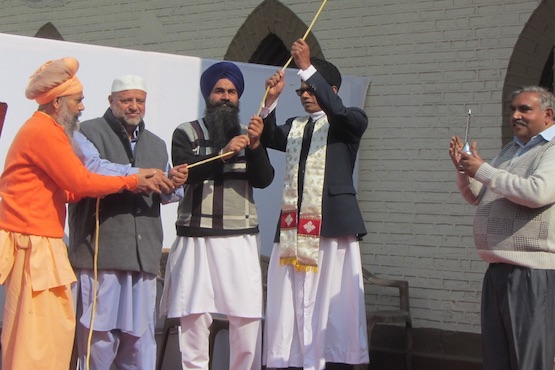Peace in Kashmir Requires a Return to Pluralism

Prior to partition, Kashmir was a princely state, ruled by the Maharaja Hari Singh. While a majority of the population was Muslim, Singh was Hindu. Because Kashmir had a majority Muslim population, the leadership of the newly created state of Pakistan believed it should rightly accede to them. But Maharaja Singh was a hold out, trying to negotiate greater autonomy for his state. To this end, he signed a “standstill” agreement with Pakistan.
Pakistan grew impatient, and in October of 1947 deployed an invasionary force of militants to force the Maharaja’s hand. The plan backfired tremendously. Rather than submit to Pakistan’s attempt at extortion, the Maharaja called for Indian military support, and India demanded he sign an Instrument of Accession to India in return. The Maharaja agreed to the terms, and war between Pakistan and India raged until a ceasefire was declared in 1949. As the dust settled, Pakistan had managed to successfully occupy about 30 percent of the Kashmir.
Pakistan’s claim to Kashmir is derived from the “two-nation theory” espoused by the country’s founders. According to this theory, Muslims and Hindus constitute wholly distinct nations, unable to co-exist under a single state. Muslims and Hindus do co-exist, of course, in nations all over the world. In fact, India today may be home to more Muslims than Pakistan – nearly 200 million. Demographic facts notwithstanding, Pakistan continues to point to the “two-nation theory” as a justification for their desire to annex the area of Kashmir they were unable to in the 1940s. Ironically, India has done much in recent years to bolster their claim.
Plagued for decades by Islamist militant groups supported by the Pakistani state, India has faced a security nightmare in Kashmir. They have responded in kind. International human rights groups have complained for decades of enforced disappearances and extrajudicial killings by Indian security forces. In recent years, India has faced high profile human rights scandals including the blindings of hundreds of civilians with metal pellets fired into crowds. In 2017, Indian security forces infamously tied a man to the front of a jeep and drove around as a warning to neighboring villages. Today, Indian forces are reportedly grabbing children off the street. Such heavy-handed and indiscriminate acts of violence have done more to alienate Kashmiris than any propaganda the Pakistanis could muster.
In addition to valid concerns about human rights abuses in Kashmir, a new talking point has entered Pakistan’s lexicon – demographics. With the abrogation of Articles 370 and 35A, Indians from outside Kashmir will be allowed to buy property. Pakistan contends this is meant to dilute the Muslim majority by facilitating an influx of Hindus. Nearly 700,000 Hindus were counted in the 1901 census – approximately 23.72% of the total population of united Jammu & Kashmir.[1] In the Kashmir Valley, Hindus comprised approximately 5.24% of the population. Today, Hindus represent approximately 28 percent of the total population of Indian Jammu & Kashmir, and only 2.45% of the population of the Kashmir Valley.
Pakistan’s fears about demographic change in Kashmir may be, at least in part, a case of “mirror imaging” – a bias effect in which one group expects another group to behave in the same way they do. Pakistanis from different regions have accused the state of having undertaken a number of efforts to manipulate demography as a means of exerting political control. Pakistani Senator Jehanzeb Jamaldini has publicly accused the government of carrying our similar programs in Balochistan. In Gilgit Baltistan, Pakistan carried out a program of demographic change to dilute the Shia majority “by resettling Sunni ex-servicemen in the area.” And in the 1990s, hundreds of thousands of Hindus were forcibly driven from Kashmir by jihadi militants.
Concerns about religious settlers only make sense in the context of Pakistan’s “two-nation theory.” Throughout history, different religious communities have successfully lived in harmony across South Asia. In the late 16th century, Muslim Emperor Jalal-ud-din Muhammad Akbar expanded and stabilized the Mughal empire in large part by adopting a secular, pluralist approach to governance. Two-hundred years later, the 1901 Census describes Muslim-majority Kashmir as peaceful despite having “an eminently Hindu Government” precisely because of the government’s “respect for the tenents [sic] and the traditions handed down to it with a spirit of infinite toleration towards the numerous religions of which the different classes of its subjects are the votaries.” If people respect each other and don’t try to force their beliefs on others, it shouldn’t matter what the demographic makeup is.
Today, discussions on Kashmir are defined by religious division. In India, popular media encourages Hindus to “reclaim” Kashmir. In Pakistan, a popular media personality called for the murder of any Hindu who tries to buy property there. In both cases, extremist messages are premised on a fictitious past.
When Kashmir was last at peace, it was neither Hindu nor Muslim. It was a place where Hindus, Muslims, Christians, Sikhs, Buddhists, and people of many other faiths lived and worked together with respect for one another as fellow Kashmiris and human beings. A return to that peace will not happen under and Islamist or Hindutva regime. Until the time that Kashmir can return to its natural state of pluralist harmony, peace will remain elusive.
[1] Includes the districts: Jammu, Kashmir, Ladakh, and Gilgit.